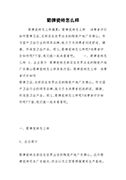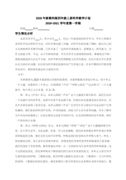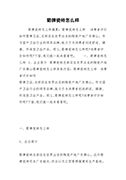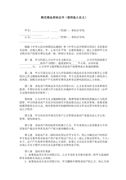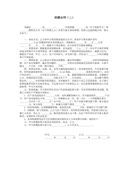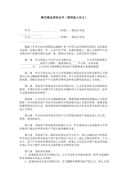中考英语语法基础专题复习(精选2篇)九年级英语教案
中考英语语法基础专题复习(精选2篇)
中考英语语法基础专题复习 篇1
【冲击XX年中考英语精品复习资料】语法基础-7
代 词 的 定 义:
代替名词, 形容词或数词的词就是代词。它们指人称和事物 ,但又不说出他们的名字,所以叫做人称代词。
代词的分类:
代词可分为八类,他们是:
1) 人称代词 5) 疑问代词
2) 物主代词 6) 连接代词
3) 指示代词 7) 关系代词
4) 反身代词 8) 不定代词
代词的用法:
1) 人称代词:
表示 " 我,你,他,我们,你们,他们等 " 的词叫做人称代词。人称代词有人称,数和格之分。
主格 宾格 主格 宾格
第一人称 i me we us
第二人称 you you you you
第三人称 he,she,it his,her,it they them
人称代词可用作主语,表语,宾语以及介词的宾语。
i am a worker, i work in the factory.
我是一个工人,我在工厂工作。
you are a good teacher.
你是一位优秀教师。
she is a little girl.
她是一个小女孩。
it's a heavy box, i can't carry it.
这是一个重盒子,我搬不动。
it's me. open the door quickly.
是我, 快开门。
don't tell him about it.
不要告诉他这件事情。
she is always ready to help us.
她随时都在准备帮助我们。
our teacher is very strict with us.
我们的老师对我们很严格。
人称代词中几个注意的情况:
第一人称单数代词 " i(我)" 不论在什么地方都要大写。
i study english every day.
我天天学习英语。
" we " 常常代替" i "表示一种同读者,听众或观众之间的亲密关系。
we shall do our best to help the poor.
我们将尽全力帮助贫困者。
" she "常常代替国家, 城市, 宠物等,表示一种亲密或爱抚的感情。
i live in china。 she is a great country.
我住在中国。 她是一个伟大的国家。
" it " 有时也可指人。
it's me. open the door, please.
是我,请开门。
" they " 有时代替一般人.
they say you are good at computer.
他们说你精通计算机。
2) 物主代词:
表示所有关系的代词叫做物主代词。物主代词可分为形容词性物主代词和名词性物主代词两种。列表如下。
形容词性物主代词和名词性物主代词
形容词性物主代词 名词性物主代词
单数 复数 单数 复数
第一人称 my our mine ours
第二人称your our yours yours
第三人称 his,her,its their his, hers,its theirs
形容词性物主代词可用作定语,例如:
i love my country.
我热爱我的国家。
is this your car?
这是你的汽车吗?
some one is looking for you, his name is tom.
有人找你,他的名字是汤姆。
名词性的物主代词可用作主语,宾语,表语以及与"of" 连接的定语。
li hua's bike is red, and yours is green.
李华的自行车是红色的,而你的是绿色的。
that car is mine, not yours.
那辆汽车是我的,不是你的。
these books are ours.
这些书是我们的。
whose bag is it? it's hers.
这是谁的书包? 是她的。
yesterday i met a friend of mine in the street.
昨天我在街上碰见了我的一位朋友。
反身代词:
表示我自己,你自己,他自己,我们自己,你们自己,他们自己等的词叫做反身代词。反身代词第一, 二人称构成是由形容词性物主代词加 "-self " (复数加 -selves )
构成。 第三人称反身代词是由人称代词宾格形式加 - self (复数加 - selves ) 构成。
单数 复数
第一人称 myself ourselves
第二人称 yourself yourselves
第三人称 himself themselves
( herself, itself )
反身代词的用法:
反身代词可用作宾语,表语,主语的同位语和宾语的同位语。用作同位语时表示强调"本人,自己"。
i am teaching myself computer.
我自学计算机。
take good care of yourself.
把自己照顾好。
the child himself drew this picture.
孩子自己画的这张画。
you should ask the children themselves.
你应该问一问孩子们自己。
指示代词:
表示这个,那个,这些,那些以及it, such, same等词叫做指示代词。指示代词在句中作主语, 宾语, 表语, 定语。
that is a red car.
那是一辆红色汽车。
what do you like? i like this.
你喜欢什么? 我喜欢这个。
i should say i know that.
我应该说我知道这件事情。
指示代词的用法:
this 和 these 表示在时间上或空间上较近的人或物。
this is a book.
这是一本书。
these are cars.
这些是汽车。
i am busy these days.
我这些日子很忙。
that 和those 表示在时间上或空间上较远的人或物。
that is not a room.
那不是一间房间。
those are threes.
那些是树。
that 和those 还可以指前文中的事物, this 和 these 指下文中将要讲到的事物。他们起一种承上或启下的作用。
i got up late, that's why i missed the bus.
我起床迟了,这就是为什么我没赶上汽车。
疑问代词 :
表示“谁(who),谁 (whom),谁的(whose),什么(what), 哪个或哪些 (which)”等词叫疑问代词。
疑问代词的用法:
疑问代词用于特殊疑问句中,疑问代词一般放在句子的最前面,在句中可用作主语,宾语,表语,定语。
who is here just now?
刚才谁来这儿?
whom are you looking for?
你在找谁?
whose exercise-book is this?
这是谁的练习本?
what is this?
这是什么?
which one do you like, this one or that one?
你喜欢哪一个,这个还是那个?
疑问代词还可以引导一个间接疑问句,也就是一个从句。疑问代词在句中可用作从句的主语,宾语,表语等成分。
what we should do is still unknown.
我们该干什么仍然还不知道。
i know whom he is looking for.
我知道他在找谁。
关系代词:
关系代词是一种引导从句起连接主句和从句的代词。关系代词有 who, whose, whom, that, which. 它们在句中可用作主语,表语,宾语,定语. 在主句中,它们还代表着从句所修饰的那个名词或代词。
this is the students whose name is wang hua.
这就是名叫王华的学生。
i know what he is coming to get.
我知道他来要拿什么东西。
不定代词:
没有明确指定代替任何特定名词或形容词的词叫做不定代词,常用的不定代词如下:
all,any,another,both,each,every,either,every, few,little, many, much, no,none,neither,one, other,some以及由 some, any, no, every 和 body, one, thing 构成的复合词。
不定代词的用法:
不定代词代替名词或形容词.在句中可用作主语, 宾语,表语和定语。
everybody should be here in time tomorrow.
明天大家都要按时到。
i know nothing about it.
这件事情我一点都不知道。
that's all i know.
这就是我知道的。
i go to school everyday.
我每天去学校上学。
不定代词的具体用法:
any 一些,任何。 any 多用作否定或疑问句中,any 在句中作主语, 宾语, 定语。 any作定语时,它所修饰的名词没有单复数限制, 一般多用复数, any 用在肯定句
中,表示"任何"。
do you have any books?
你有书吗?
you can come any time.
你什么时候都可以来。
some 一些,某些,某个。 some 多用在肯定句中,表示邀请或者对方可能给予肯定回答的疑问句中等。
there are a lot of flowers in the garden, some are white, which i like very much.
花园里有许多花,一些是白色的,我特别喜欢。
i am going to get some ink.
我去弄点墨水。
will you have some coffee, please?
喝点咖啡吗?
no 无.在句中作定语.表示否定,语气要比 not any 强.
she knows no english.
她根本就不懂英语。
i have no bike.
我就没有自行车。
none 无人,无物,无东西.在句中作主语 ,定语,宾语。 none 在句中代替不可数名词作定语时, 谓语动词要用单数形式。 none 在句中代替可数名词作定语时, 谓语动词要用复数形式。
none of them are workers.
他们没一个是工人。
it's none of your business.
这不碍你的事。
many 许多.在句中作主语,宾语 ,定语. many 在句中代替可数名词。
many of the students like english very much.
许多学生非常喜欢英语。
i have many books to give you.
我有许多书要给你。
much 许多。在句中作主语,宾语,定语。much 在句中代替不可数名词。
there is not much ink in the bottle.
瓶子里没多少墨水了。
a few,a little,few,little. 几个,一点儿,没几个, 没多少。它们在句中作主语,宾语,定语,其中 a few 和 few 代替可数名词 , a little 和 little 代替不可数名词,它们表示少量,不多,几个, 只是主观上的一种相对说法,并没有具体的数量标准。
few of the books are cheap now.
现在没几本儿书是便宜的。
a few friends came to see me yesterday.
昨天有几个朋友来看我。
i have a little money to buy the book.
我的这点钱能买这本书。
there is little water in the thermos.
暖水瓶没多少水了。
中考英语语法基础专题复习 篇2
【冲击XX年中考英语精品复习资料】语法基础-8
动词不定式是一种非谓语动词的形式
非谓语动词指的是在句中起名词,形容词或副词作用的动词形式,而不是作谓语的动词形式。 动词的非谓语形式分为动名词,分词,动词不定式。
climbing mountain is a good exercise. (climbing..., 动名词起名词作用)
爬山是一项好运动。
do you know the man wearing a white shirt. (wearing ... 分词起形容词作用)
你认识那个穿白衬衣的人吗?
he gets up early to catch the first bus. (to catch .... 不定式起副词作用)
他早早起床是为了赶上第一班汽车。
谓语动词和非谓语动词的区别:
1) 谓语动词在句中可单独作谓语,而非谓语动词不能单独作谓语。
miss mary teaches us english.
玛丽教我们英语。(teaches 动词作谓语)
mr.victor came to our classroom to have a talk with us last week.
维克托先生上周来到了我们教室和我们谈话。 (to have a talk.... 不定式作状语)
2) 谓语动词受主语的人称和数的限制,而非谓语动词形式没有这种限制。
larke likes the pop music.
拉克喜欢流行音乐。 (动词用单数第三人称形式)
larke has nothing to do today.
拉克今天没什么事要做。(do 用原形)
非谓语动词的特征:
1 如果非谓语动词是及物动词,后面须跟宾语。
studying english is my favorite.
学习英语是我的爱好。(studying 后跟宾语)
to help him is my duty.
帮助他是我的责任。(help 后跟宾语)
2 非谓语动词可以带有自己的状语或逻辑主语。
working under such a condition is terrible.
在这样的环境下工作太可怕了。(under such a condition 是 working 的状语)
it's too difficult for him to master english in such a short time.
他在这么短的时间内掌握英语太难了。(for him 作不定式的逻辑主语)
3 非谓语动词仍有语态和时态的变化。
i am sorry to have kept you waiting long.
对不起让你久等了。(to have kept...是不定式的完成形式)
seen from the mountain, the city looks much more beautiful.
从山上看,这座城市美丽多了。(seen from...是分词的被动形式)
4 非谓语动词在句中可以当成名词或者形容词来使用。
our coming made him happy.
我们的到来使他很高兴。(coming 起名词作用)
there are two big swimming pools here.
这儿有两个大型游泳池。(swimming 起形容词作用)
非谓语动词的形式变化:
不 定 式 主 动 被 动
一般 to write to be written
进行 to be writing /
完成 to have written to have been written
完成进行 to have been writing /
现 在 分 词 主 动 被 动
一般 writing being written
完成 having written having been written
过 去 分 词 一般 written
动 名 词 主 动 被 动
一 般 writing being written
完 成 having written having been written
动 词 不 定 式:
动词不定式是由 to + 动词原形构成,在句中起名词,形容词和副词的作用,可以担任除谓语以外的其它任何成分。
1 动词不定式作主语:
to mast a language is not an easy thing.
掌握一门语言不是一件容易的事情。
to teach english is my favorite.
教英语是我的爱好。
it's my pleasure to help you.
很乐意帮助你。
动词不定式作主语时可以放在后面,而用 it 作形式主语放在原主语的位置上。
it's very kind of you to have given us much help.
你给了我们那么多的帮助真是太好了。
it's necessary to find the witness.
有必要找到目击者。
2 动词不定式作宾语:
某些及物动词可以用动词不定式作宾语,这些动词有decide, begin, help, begin, want, wish, like, forget, learn, ask.
what i wish is to learn english well.
我所希望的是把英语学好。
i like to help others if i can.
如果有可能的话,我喜欢帮助别人。
3 动词不定式作宾语补语 。
we expect you to be with us.
我们希望你和我们在一起。
please ask him to come here quickly.
请叫他快过来。
4 动词不定式作表语 :
what i should do is to finish the task soon.
我应该做的是赶快完成任务。
the most urgent thing is to find the boy immediately.
当务之急是马上去找孩子。
5 动词不定式作定语:
there are many ways to solve the problem.
有许多方法能解决这个问题。
i have something important to tell you.
我有重要的事情要告诉你。
6 不定式作状语:
we went to the hospital to see our teacher.
我们去医院看了我们的老师。
she is making a test to get a kind of useful
medicine from a tibet flower.
她在做试验,从一种西藏花中提取某种有用的药物。
动词不定式的否定形式:
not + to + 动词原形
the teacher told us not to swim in that river.
老师告诉我们不要在那条河里游泳。
it's unfair not to tell us.
没告诉我们真是不公平。
带疑问词的不定式:
疑问词who, what,which,when, where, how, why 可以加在不定式的前面,构成不定式短语,使含义更加具体。
where to go is not known yet.
去什么地方还不知道。
i don't know when to begin.
我不知道什么时间开始。
can you tell me where to get the battery.
你能告诉我哪儿能买到电池吗?
do you know how to get to the station.
你知道怎样去车站吗?
带逻辑主语的不定式:
动词不定式可以带有自己的逻辑主语,构成方法是: for + 逻辑主语 + 不定式。
注意:逻辑主语用宾格形式, for 本身无实际意义,它只表明后面的主语从逻辑上分析是不定式的主语。
it's necessary for us to help each other.
我们互相帮忙是必要的。
there are much work for me to finish,
有许多工作要我去完成。
动词不定式的时态:
动词不定式一般时:表示动作和句中谓语动词的动作同时发生或之后发生。
i helped him put the things into the car.
我帮助他把东西放进了汽车。
i want to see you again.
我想再见到你。
would you like to have a rest.
你愿意休息一下吗?
动词不定式完成时: 表示动作在句中谓语动词的动作之前发生。
we are sorry to have kept you waiting so long.
对不起,我们让你久等了。
they seems to have known the answers.
他们好像知道了答案。
动词不定式进行时:表示动作同句中谓语动词的动作同时发生,强调动作正在进行。
they seem to be working hard.
他们好像在努力工作。
动词不定式的被动形式: 表示不定式动词同所修饰的名词是被动关系 。
he is the man to be examined.
他是受检查的人。
there are much work to be done.
有好多工作要做。


